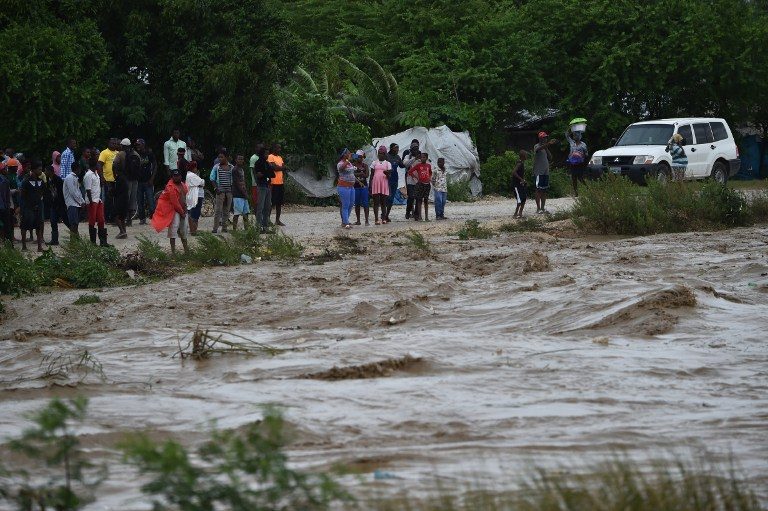SUMMARY
This is AI generated summarization, which may have errors. For context, always refer to the full article.

PORT-AU-PRINCE, Haiti (UPDATED) – Hurricane Matthew, the Caribbean’s worst storm in nearly a decade, barreled towards the Bahamas Wednesday morning, October 5, after killing 9 people and pummeling Haiti and Cuba.
Far to the north, the first evacuations were ordered in the United States as coastal residents prepared to escape the approaching monster storm, expected off the East Coast later this week.
In Haiti, severe flooding and devastating winds caused untold damage to the Americas’ poorest nation, where officials were still struggling to communicate with the country’s hard-hit south, where telecommunications had been disrupted.
The collapse of a bridge cut off the only road linking Port-au-Prince to the peninsula that makes up southern Haiti, making matters worse.
The storm’s overall death toll stands at nine – 5 in Haiti and 4 in the Dominican Republic – but was certain to rise as Matthew bruised its way north.
A partial assessment of the damage in Haiti, which excluded the department of Grande Anse, which was in the direct eye of the storm, indicated that 14,500 people had been displaced and 1,855 homes flooded. Those numbers were expected to increase dramatically once communication is reestablished with the area.
One person has been reported missing and around 10 injured so far in Haiti, officials said.
Next in line, Cuba was hit late Tuesday afternoon on its eastern tip.
The storm’s eye made landfall around 0000 GMT but its center has already moved northeast of the island, heading north at 13 kilometers (eight miles) per hour, the US National Hurricane Center said.
Americans meanwhile girded for a taste of nature’s fury.
Florida and South Carolina as well as parts of North Carolina and Georgia have declared states of emergency. South Carolina said it would start evacuating 1.1 million people from its coast Wednesday and try to get them at least 160 kilometers inland.
“It’s not going to be a fast evacuation. It could take up to several hours,” South Carolina Governor Nikki Haley said. “If you can leave early, do that.”
‘Extremely dangerous’
Matthew made landfall in Haiti shortly after daybreak Tuesday as an “extremely dangerous” Category Four storm — the maximum is five — near the southwestern town of Les Anglais, packing top winds of around 230 kilometers per hour, the NHC said.
It marked the first time in 52 years that a Category Four storm made landfall in Haiti.
Even before making landfall on the southern edge of a jagged peninsula on Hispaniola — the island that Haiti shares with the Dominican Republic — Matthew was blamed for at least three deaths in Haiti. Two additional deaths have since been reported, with fears that the toll could climb.
Four deaths have been reported in the Dominican Republic, where officials said 200 homes were damaged.
The storm is expected to hit the Bahamas next, moving across the islands through Thursday and nearing the coast of Florida Thursday evening, the NHC said.
Matthew was forecast to dump 38 to 63 centimeters (15 to 25 inches) of rain over southern Haiti with up to a meter possible in isolated areas, and has been blamed for triggering mudslides.
The key port of Les Cayes, the country’s third city is “very seriously damaged,” said Hervil Cherubin, Haiti director for the aid group Heifer International. “Most roofs of houses, shops, gas stations are all gone.”
“Businesses near the ocean have totally disappeared, washed away,” he added, with farms having “disappeared” and livestock been killed.
The country is home to almost 11 million people, many living in fragile housing.
Thousands are still living in tents in Haiti after the country’s massive earthquake in 2010. Erosion is especially dangerous because of high mountains and a lack of trees and bushes in areas where they have been cut for fuel.
More than 9,000 Haitians were evacuated to temporary shelters at schools and churches, the Interior Ministry said.
But civil protection forces have struggled with locals who refused to leave some of the most vulnerable areas.
Schools will remain closed until Monday, but the authorities have not said whether long-delayed presidential and legislative elections scheduled for Sunday will still take place.
‘Food for today, tomorrow’
Matthew already holds the longevity record for a Category Four and Five hurricane in the Caribbean, according to meteorologist Philip Klotzbach from Colorado State University.
Officials reported significant flooding and waves up to five meters (16 feet) in coastal villages in the east of Cuba — but no casualties so far.
Cuban authorities evacuated some 1.3 million people.
One stalwart who stayed, 63-year-old Roberto Gates, ventured out to buy rum. “I have food for today and tomorrow, and then we’ll see,” he said.
The United States Agency for International Development (USAID) dispatched an elite disaster response team to the Bahamas, Haiti and Jamaica.
It is also sending some $400,000 in assistance to aid groups in Haiti and Jamaica and emergency relief supplies including blankets, plastic sheeting and water containers.
The Pentagon said 700 family members of personnel were evacuated from the US naval base in Guantanamo Bay, on Cuba’s eastern tip, over the weekend to Florida.
President Barack Obama postponed a trip to South Florida, where he had planned to attend a campaign event in support of Democratic presidential candidate Hillary Clinton. – Rappler.com
Add a comment
How does this make you feel?
There are no comments yet. Add your comment to start the conversation.